
Anzac Day is a national day of remembrance in Australia, New Zealand and Tonga that broadly commemorates all Australians and New Zealanders "who served and died in all wars, conflicts, and peacekeeping operations" and "the contribution and suffering of all those who have served". Observed on 25 April each year, Anzac Day was originally devised to honour the members of the Australian and New Zealand Army Corps (ANZAC) who served in the Gallipoli campaign, their first engagement in the First World War (1914–1918).
HMAS Orion was an Oberon-class submarine of the Royal Australian Navy (RAN). One of six submarines ordered by the RAN during the 1960s, Orion, named after the constellation in a break from ship-naming tradition, was built in Scotland and commissioned in 1977. Orion was one of two Oberon-class submarines designed for intelligence gathering and conducted regular patrols in Soviet, Indian and Chinese waters to gather information regarding enemy capabilities.

Keith Payne, is a retired Australian soldier and a recipient of the Victoria Cross (VC), the highest decoration for gallantry "in the presence of the enemy" awarded to members of the British and Commonwealth armed forces. Payne's VC was awarded for his actions during the Vietnam War. Aged 91, he is the last living Australian recipient of the original Imperial Victoria Cross.
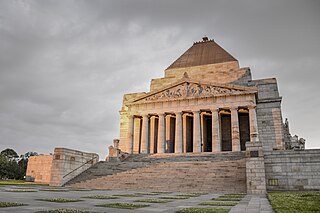
The Shrine of Remembrance is a war memorial in Melbourne, Victoria, Australia, located in Kings Domain on St Kilda Road. It was built to honour the men and women of Victoria who served in World War I, but now functions as a memorial to all Australians who have served in any war. It is a site of annual observances for Anzac Day and Remembrance Day, and is one of the largest war memorials in Australia.
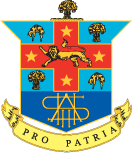
Hurlstone Agricultural High School is a government-funded co-educational academically selective and specialist secondary day and boarding school, located in Glenfield, a south-western suburb of Sydney, in the Macarthur region of New South Wales, Australia. HAHS is the oldest government boarding school in New South Wales.
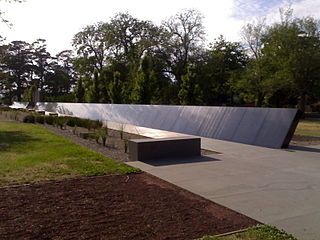
The Australian Ex-Prisoners of War Memorial was dedicated on Friday, 6 February 2004. It is located on the southern approaches to the Ballarat Botanical Gardens, on Wendouree Parade and adjacent to Lake Wendouree.

Rockingham Naval Memorial Park is a military memorial in the City of Rockingham, Western Australia, dedicated to the Royal Australian Navy. It contains a number of commemorative plaques, a 110-millimetre (4.5 in) gun turret from HMAS Derwent and a submarine fin from HMAS Orion.
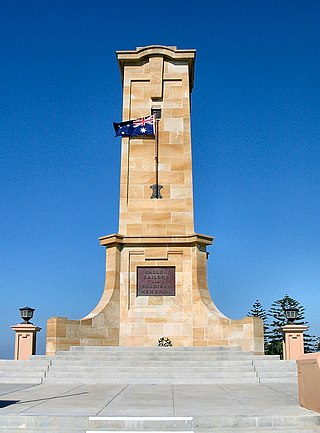
The Fremantle War Memorial is a war memorial located on Monument Hill, an 11-acre (4.45-hectare) public reserve and hill in Fremantle, Western Australia. The memorial itself comprises a large obelisk, the Fallen Soldiers' and Sailors' Memorial, surrounded by eight smaller memorials. The site, located on High Street near the centre of Fremantle, overlooks Fremantle Harbour, and was established by the Fremantle Town Council in 1928 to commemorate the losses of the First World War, having been used as a public reserve since the early 19th century.
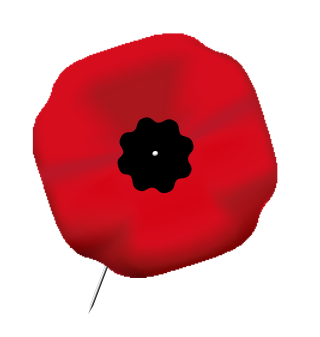
The First World War centenary was the four-year period marking the centenary of the First World War, which began in mid-2014 with the centenary of the outbreak of the war, and ended in late 2018 with the centenary of the 1918 armistice.
The Avro Anson Memorial, also known as the RAAF Anson Aircraft Memorial, Air Disaster Memorial, or Mokine Memorial, commemorates four Royal Australian Air Force (RAAF) airmen killed when their Avro Anson aircraft crashed near Clackline, Western Australia on 9 October 1942. The memorial, assembled by members of the local community in the months following the crash, features a cairn of granite and boulders supporting a jarrah cross. The names and details of the deceased airmen − Flying Officer Lynton Birt, Sergeant Geoffrey Debenham, Sergeant Noel Nixon, and Sergeant Kenneth Hugo − are carved into the cross. Birt was interred in the Northam Cemetery, and later reinterred in the Perth war cemetery and annex (N.A.8) while the others were buried at Karrakatta Cemetery.

The London Troops War Memorial, located in front of the Royal Exchange in the City of London, commemorates the men of London who fought in World War I and World War II.

Soldiers' Memorial Hall is a heritage-listed community hall at 63 Nicholas Street, Ipswich, City of Ipswich, Queensland, Australia. It was designed by George Brockwell Gill and built by F.J. Lye from 1920 to 1921. It is also known as Memorial Hall. It was added to the Queensland Heritage Register on 21 October 1992.

Anzac Day is a day of remembrance in Queensland, Australia. It is a public holiday held on 25 April each year. The date is significant as the Australian and New Zealand troops first landed at Gallipoli in World War I on 25 April 1915.

Cairns War Memorial is a heritage-listed memorial at The Esplanade, Cairns City, Cairns, Cairns Region, Queensland, Australia. It was built in 1925. It was added to the Queensland Heritage Register on 21 October 1992.
The Centenary of Western Australia Women's Suffrage Memorial is located in the Western Australia Botanic Garden, within Kings Park in Perth, Western Australia. It commemorates the hundredth anniversary of women achieving the right to vote equally with men in Western Australian elections.
The Centenary of Women's Suffrage Gazebo is located in the town of Kondinin, Western Australia. It was built in 1999 to commemorate the centenary of women's suffrage in Western Australia.

The Muster Point is a monumental public sculpture in Newcastle, Australia that commemorates the Newcastle Steelworks of BHP and its workers. The plant closed after 84 years in operation. One former worker estimated that "from 1915 to 1961 over 67,000 people had worked on the site". It was fabricated of steel and bronze by sculptor Julie Squires and BHP workers in the Fabrication Shop before the plant closed down. The seventy tonne monument is eight metres high, sixteen metres long and twelve metres wide, and demonstrates the significance of steel making to the city of Newcastle. It was installed on Industrial Drive, in the suburb of Mayfield in 1999.
The three branches of the Australian Defence Force are each represented by flags, among other emblems and insignia. Within each service, various symbols fly on individual ships, at bases, camps, the Australian Defence Force Academy and colleges. These include flags, standards, guidons and banners and that denote rank, appointment, corps, formations, regiments, training units and sub-units.

Exmouth Submarine Base, called Operation Potshot, was a United States Navy base at Exmouth Gulf, Western Australia during World War II. Exmouth Gulf on western Australia was selected as the site for US Naval base as it was thought at the time to be out of the reach of Empire of Japan's long-range bombers. Bombing of Darwin on February 19, 1942, demonstrated a more southern port was needed. The Submarine operation at Exmouth Gulf and the North West Cape was called Operation Potshot, named after the Potshot airfield that provided fighter plane cover for the base.















